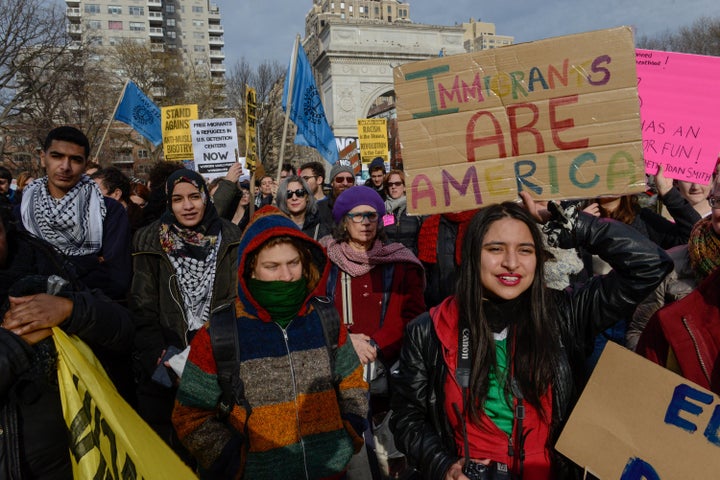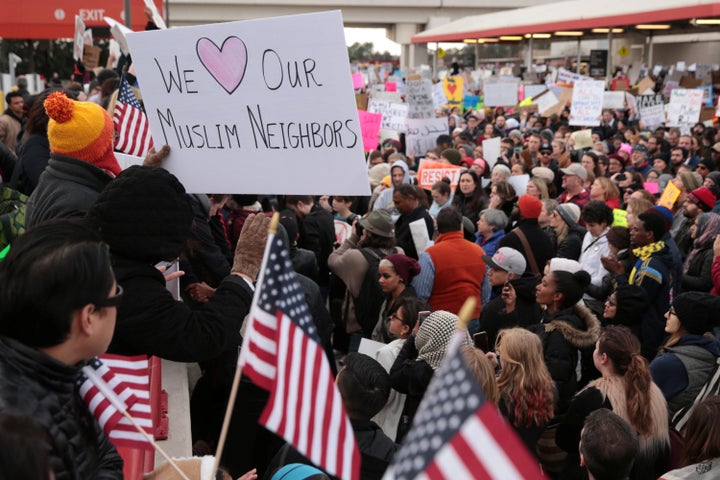For HuffPost’s #LoveTakesAction series, we’re telling stories of how people are standing up to hate and supporting those most threatened. What will you stand up for? Tell us with #LoveTakesAction.
Since the November presidential election, waves of people have taken to the streets in protest ― and young people are leading the charge.
Millennials ages 18 to 30 are more likely to have gone to a protest since the election than any other age group, according to a HuffPost/YouGov poll conducted from Feb. 1 to Feb. 3. Millennials are also more likely than older groups to think protesting is an effective form of political action.
“If there are more, younger people taking to the streets, it may indicate that young people have less trust in how institutions would respond to their demands,” said Dr. Guobin Yang, an associate professor at the University of Pennsylvania and the director of the school’s Media Activism Research Collective.
“I see this as a sign that the younger generation does not seem to trust the institutional channels of participation as much as their parents or older generations do,” Yang added.
Among people who have taken any form of political action in their lifetime, 24 percent of 18- to 30-year-olds say they’ve gone to a rally or demonstration since the election, compared to only around 10 percent of people ages 30 to 44; 45 to 64; or 65 and older.
Young people also rank protest as one of the two most effective political actions one can take, alongside calling or writing their representatives. Older age groups rank protests’ effectiveness below other forms of political actions that rely on more traditional, institutional channels, such as calling representatives or signing petitions.
It’s worth noting that younger people are more likely to vote Democrat, and the HuffPost/YouGov poll found Democrats are generally more likely to think protest is effective and to have protested in their lifetime. The poll showed young people who took political actions did so 62 percent in opposition to Trump, versus 18 percent in support of Trump.

So far, it remains to be seen how effective mass protests will be in pushing back on the Trump administration agenda.
Experts provide a wide range of suggestions on what kinds of political actions are most effective: Some suggest calling representatives over emailing or writing; others say in-person meetings with legislators are best; still others note that disruption through protest has achieved a lot historically.
“Each can be effective in their own way, and the key factor is to see how American political institutions respond to these forms of expressing demands,” Yang said.
““I think the recent wave of protests has worked.”
- Dr. Guobin Yang, director of the Media Activism Research Collective
“I think the recent wave of protests has worked,” Yang said. “Think of the Women’s March. It happened all over, with huge numbers, and it was about expressing solidarity.”
“Among many voters after the election, there was a great sense of disillusionment,” Yang added. “The Women’s March brought out people to show: You are not alone, and you can work together for social justice. [At the march], you felt a kind of strength you wouldn’t have as an individual in your own home. I would see this as a major achievement.”
Yang also pointed to the success of the nationwide airport protests in response to Trump’s executive order limiting refugees and immigration from seven Muslim-majority countries.
“The opposition to the executive order had more concrete goals,” Yang said. “Yes, it was to express outrage ― how can our country have such an order that goes against our values ― but it also had a concrete goal to resist the order, and to ensure it would be invalidated. In that sense, it was a successful mobilization.”
Trump’s executive order has been mired in political and legal challenges. Trump said last week that his administration would issue a new order on immigration to bypass previous judicial blocks.

Recent protests recall the radical movements of the 1960s and early 1970s, according to Yang, when street demonstrations were a common and powerful tool for change. But those radical movements also eventually ran out of steam.
“American political culture underwent a deep transformation,” Yang said. “More and more, citizens’ expressed opposition has become less radical, much more reliant on institutional forms of participation, like calling reps or [volunteering] through nonprofits ― partly reflecting the exhaustion of radical politics.”
“Nonviolent forms of protest are always more effective.”
- Dr. Guobin Yang, director of the Media Activism Research Collective
For today’s movement to be successful, according to Yang, activists need to use a combination of tactics, and remember some key lessons from the 1960s.
“People should use different forms of action in combination: Some are calling reps, some are joining rallies, and that’s important,” Yang said. “Historically [looking] in the 1960s, when mass-scale protests keep happening, there are occasions where violence will happen, and this is something protesters want to watch out for. Nonviolent forms of protest are always more effective.”
“And large-scale rallies are tiring,” Yang added. “You can’t go for hours every week, people have families ― so it comes down to organizing a sustainable movement, to build communities where even when there aren’t large-scale activities, people still have support and can share ideas.”
Ariel Edwards-Levy contributed reporting.
Know a story from your community of people fighting hate and supporting groups who need it? Send news tips to lovetips@huffingtonpost.com.
The HuffPost/YouGov poll consisted of 1,000 completed interviews conducted Feb. 1 to Feb. 3 among U.S. adults, using a sample selected from YouGov’s opt-in online panel to match the demographics and other characteristics of the adult U.S. population.
The Huffington Post has teamed up with YouGov to conduct daily opinion polls.You can learn more about this project and take part in YouGov’s nationally representative opinion polling. Data from all HuffPost/YouGov polls can be found here. More details on the polls’ methodology are available here.
Most surveys report a margin of error that represents some, but not all, potential survey errors. YouGov’s reports include a model-based margin of error, which rests on a specific set of statistical assumptions about the selected sample, rather than the standard methodology for random probability sampling. If these assumptions are wrong, the model-based margin of error may also be inaccurate. Click here for a more detailed explanation of the model-based margin of error.


